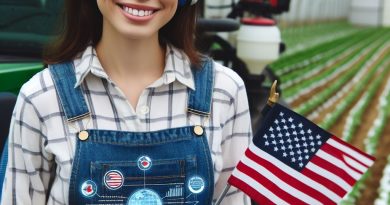Navigating US Agricultural Import Restrictions
Last Updated on February 24, 2024
Introduction
Brief overview of the topic
Navigating US Agricultural Import Restrictions can be a complex and daunting task for businesses and individuals involved in the agricultural industry.
The United States imposes various restrictions on the importation of agricultural products, aiming to protect domestic industries, maintain food safety standards, and prevent the introduction of harmful pests and diseases.
Importance of understanding agricultural import restrictions in the US
Understanding the agricultural import restrictions in the US is crucial for anyone involved in international trade of agricultural products.
Failure to comply with these regulations can result in customs issues, fines, shipment delays, and even the refusal of entry for products.
Additionally, being aware of these restrictions helps businesses plan their import strategies effectively, ensuring compliance with all legal requirements and preventing any potential losses or disruptions to their trade operations.
In this blog section, we will explore the key aspects of US agricultural import restrictions to help businesses and individuals navigate through the complex regulatory landscape.
We will discuss the different regulations imposed by government agencies, such as the United States Department of Agriculture (USDA) and the Animal and Plant Health Inspection Service (APHIS).
Furthermore, we will delve into the specific requirements for importing various agricultural products, including fresh fruits and vegetables, meat and poultry, grains, and dairy products.
By gaining a comprehensive understanding of the US agricultural import restrictions, businesses and individuals can effectively navigate the regulatory framework and ensure successful import operations.
Let’s dive into the intricacies of these regulations and discover practical tips and insights to streamline import processes while adhering to all legal requirements.
Understanding US Agricultural Import Regulations
Overview of relevant government agencies and regulations
Several government agencies are involved in regulating agricultural imports in the United States. The primary ones include:
The United States Department of Agriculture (USDA)
The Animal and Plant Health Inspection Service (APHIS)
The Food and Drug Administration (FDA)
The Environmental Protection Agency (EPA)
Each agency has its specific role and regulations that importers must comply with.
Key factors that influence agricultural import restrictions
When it comes to agricultural imports, there are three main factors that influence the restrictions imposed:
- Food safety concerns: Import regulations aim to protect consumers from potential health risks posed by contaminated or unsafe imported food.
- Protection of domestic agricultural industry: Import restrictions may be imposed to prevent unfair competition with domestic farmers and ensure their economic stability.
- Environmental considerations: Regulations are in place to prevent the introduction of invasive species or harmful organisms that could harm the environment and native ecosystems.
Differences in regulations for different types of agricultural products
Regulations for agricultural imports vary depending on the type of product being imported. Here are some examples:
- Fresh produce: The USDA’s APHIS sets regulations to prevent the introduction of pests and diseases that could harm crops.
- Meat and poultry: The USDA’s Food Safety and Inspection Service (FSIS) ensures that imported products meet their safety and labeling standards.
- Dairy and eggs: The FDA regulates the import of dairy and egg products, including ensuring compliance with sanitary and quality standards.
It’s crucial for importers to be aware of these differences and fulfill the specific requirements for each product category.
Read: Impact of EPA Rules on Farm Chemicals
Major US Agricultural Import Restrictions
Plant and animal health requirements
- Phytosanitary regulations: Regulations concerning the spread of pests and diseases through plants.
- Quarantine measures: Steps taken to prevent the introduction and spread of infectious diseases in animals and plants.
- Veterinary inspections: Examinations carried out to ensure the health and safety of imported animals and animal products.
Tariffs and trade barriers
- Tariff rates and classification of agricultural products: Taxes imposed on imported agricultural goods based on their classification.
- Trade agreements and exemptions: Special agreements and exceptions that allow certain agricultural products to enter the US market more easily.
- Non-tariff barriers such as quotas and licensing requirements: Restrictions on the quantity or type of agricultural products that can be imported.
Navigating the complexities of US agricultural import restrictions can be a daunting task for businesses involved in international trade. Understanding and complying with the major barriers is crucial for a successful import strategy.
Plant and animal health requirements
Phytosanitary regulations play a vital role in protecting US agriculture from the introduction and spread of pests and diseases. These regulations aim to prevent the entry of harmful organisms that could pose a significant threat to local crops and ecosystems.
To comply with phytosanitary regulations, importers must provide necessary documentation, such as phytosanitary certificates, to prove that imported plants and plant products are free from pests and diseases.
Inspection and testing may also be required to ensure compliance.
Quarantine measures are another crucial aspect of plant and animal health requirements.
The United States Department of Agriculture (USDA) enforces quarantine restrictions on agricultural products to prevent the introduction and spread of infectious diseases.
Imported animals, animal products, and plants may be subject to quarantine periods to eliminate any potential health risks before they can enter the US market.
Furthermore, veterinary inspections are conducted to verify that animals and animal products imported into the United States meet health and safety standards.
The USDA’s Animal and Plant Health Inspection Service (APHIS) is responsible for inspecting and approving the importation of animals and animal products, which helps safeguard domestic livestock and protects public health.
Tariffs and trade barriers
These are another significant aspect of US agricultural import restrictions. Tariffs are taxes levied on imported goods, including agricultural products, based on their classification.
Importers must understand the tariff rates applicable to their products to accurately determine the cost of importing.
Trade agreements play a crucial role in reducing tariff rates or exempting certain agricultural products from tariffs altogether.
For example, the United States has entered into various trade agreements, such as the North American Free Trade Agreement (NAFTA) and the United States-Mexico-Canada Agreement (USMCA), which aim to facilitate agricultural trade among member countries.
Apart from tariffs, non-tariff barriers can also hinder agricultural imports.
These include quotas, which restrict the quantity of a specific product that can be imported, and licensing requirements, which mandate importers to obtain special permits or licenses before bringing goods into the country.
Such barriers are designed to protect domestic agricultural industries and ensure a level playing field.
In essence, navigating US agricultural import restrictions requires a comprehensive understanding of plant and animal health requirements, as well as tariffs and trade barriers.
Compliance with phytosanitary regulations, quarantine measures, and veterinary inspections is crucial to ensure the health and safety of imported goods.
Additionally, a keen understanding of tariff rates, trade agreements, and non-tariff barriers is essential to successfully navigate the complex world of US agricultural imports.
Read: Federal Water Usage Laws for US Farms in 2024

Navigating the Process of Importing Agricultural Products
Identifying import requirements and restrictions
Importing agricultural products into the United States can be a complex process. It is essential to identify and understand the import requirements and restrictions to ensure a smooth and lawful importation. There are several steps involved in navigating this process.
Researching product-specific regulations
Each agricultural product may have specific regulations and requirements for importation. It is crucial to thoroughly research and understand these regulations before proceeding with the importation process.
Factors such as labeling, documentation, and safety standards may vary depending on the type of product being imported. For example, fresh produce may have different regulations compared to processed food products.
Consulting with relevant government agencies
Government agencies play a significant role in regulating agricultural imports. It is advisable to consult with these agencies to ensure compliance with all necessary regulations and to obtain accurate and up-to-date information.
Agencies such as the United States Department of Agriculture (USDA) and the Food and Drug Administration (FDA) can provide guidance on import requirements, permitting, and other relevant information.
Obtaining necessary permits and certifications
Once the import requirements have been identified, it is essential to obtain the necessary permits and certifications to import agricultural products legally.
Failure to obtain these documents can lead to delays, penalties, or even a complete prohibition on importing the products.
Documentation needed for importation
Each imported agricultural product requires specific documentation, such as a phytosanitary certificate or import permit. These documents verify that the products meet the required standards and are free from pests or diseases.
It is crucial to gather and submit all the necessary documents promptly to avoid any complications in the import process.
Accreditation and certification processes
In some cases, importers may need to obtain specific certifications or accreditations to ensure compliance with quality and safety standards.
These certifications may include good agricultural practices (GAP) certification or organic certification. The process of obtaining these certifications may involve inspections, audits, and meeting certain criteria set forth by the relevant authorities.
Complying with labeling and packaging requirements
Correct labeling and packaging are crucial when importing agricultural products into the United States. These requirements aim to ensure transparency, traceability, and food safety.
Country of origin labeling
Imported agricultural products must be clearly labeled with their country of origin. This labeling provides information to consumers and allows them to make informed choices while also complying with regulations set forth by the Federal Trade Commission (FTC).
Packaging regulations for food safety
To ensure the safety of consumers, imported agricultural products must adhere to packaging regulations. These regulations often relate to the use of tamper-evident seals, appropriate labeling of allergens, and proper handling and storage instructions.
Compliance with these regulations is vital to prevent health risks and maintain product quality.
Navigating the process of importing agricultural products into the United States requires thorough research, consultation with relevant authorities, and compliance with regulations.
By understanding and following these steps, importers can ensure a smooth and legal importation process, while also prioritizing the safety and integrity of the agricultural products being imported.
Read: USDA Subsidies: What’s New in 2024?
Overcoming Challenges and Ensuring Compliance
Working with experienced customs brokers or trade consultants
One of the most effective ways to navigate US agricultural import restrictions is by partnering with experienced customs brokers or trade consultants.
These professionals specialize in import regulations and can provide valuable guidance and support throughout the process.
Staying informed about updates and changes in regulations
Monitoring government websites and announcements
Regularly checking government websites and announcements is crucial for staying up-to-date with any changes or updates in agricultural import regulations. This ensures compliance and avoids any potential penalties or delays.
Subscribing to industry newsletters and publications
Subscribing to industry newsletters and publications is another effective way to stay informed about the latest developments in agricultural import restrictions. These sources often provide timely updates and insights.
Maintaining accurate records and documentation
Importance of record-keeping for audits and inspections
Keeping accurate records and documentation is essential for complying with US agricultural import restrictions. In the event of an audit or inspection, having organized and detailed records can help demonstrate compliance.
Digital solutions for organizing and managing import data
Utilizing digital solutions, such as import management software, can greatly streamline the process of organizing and managing import data. These tools help ensure accuracy and accessibility of important documents and information.
Read: Water Laws Impact on US Crop Growth
Conclusion
Recap of key points discussed in the blog post
US agricultural import restrictions are in place to protect against plant and animal diseases.
Inspection and documentation requirements must be met for imported agricultural products.
Failing to comply with import restrictions can result in penalties and impacts on domestic agriculture.
Emphasis on the significance of complying with agricultural import restrictions
Complying with import restrictions is crucial for safeguarding the agricultural industry and ensuring food safety.
Encouragement for readers to seek professional assistance and resources for navigating the process
When dealing with agricultural imports, consulting experts and utilizing available resources is essential for success.


